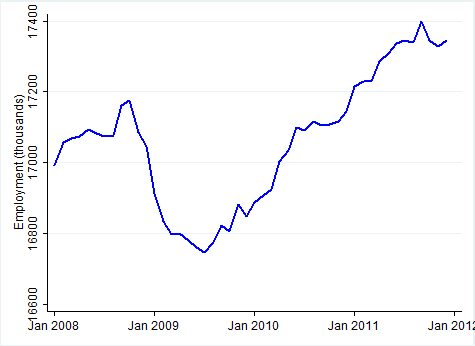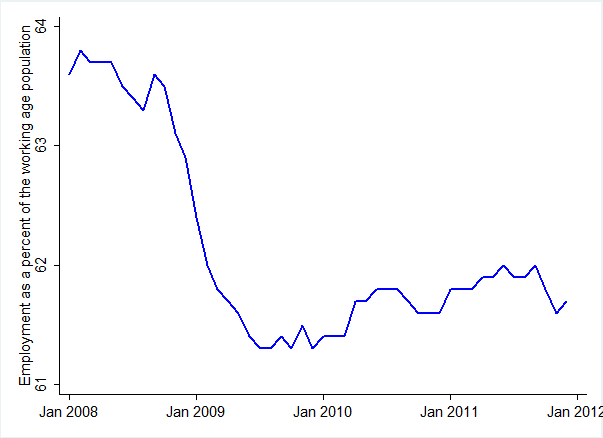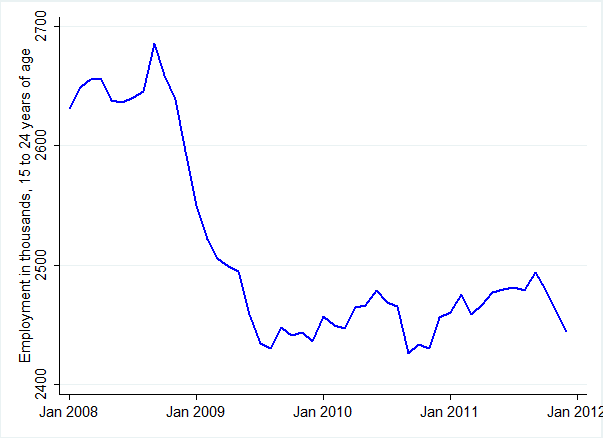This morning Statistics Canada released–as it does on the first Friday of every month–estimates of employment and unemployment for the previous month.
As usual the headline number is the change in the number of employed, and the Agency’s press release announces that “Following two months of declines, employment rose slightly in December, up 18,000.”
But this masks as much as it reveals.
With today’s numbers the picture for 2011 is complete, and Statistics Canada is inviting a medium term look at some other facts that aren’t always highlighted and, in a couple of cases, missing.
1. Employment growth has only just kept up with the population, and in this sense has yet to recover from the recession
The economy recovered all the jobs lost during the recession at the beginning of last year, and at that point began to push beyond the peak of 17.2 million reached in October 2008 before things turned south. By the end of the year not quite 17.4 million Canadians held a job.
But all the employment growth since the low reached in the summer of 2009 has only kept up with the population, the fraction of Canadians working has hardly changed at all.
Here is the graph that traditionally leads the Statistics Canada press release.

But here are the same numbers expressed as a fraction of the working age population.

2. The situation for young people is not much better than two years ago, during the depth of the recession
Employment has not recovered for everyone.
Canadians in their prime working years (the 25 to 54 year olds) have just barely rounded the corner, but most importantly the situation for the young has not improved at all.
A quarter of a million 15 to 24 year olds lost their jobs between September 2008 and August 2009, but by the end of 2011 only about 15,000 were recovered.

All the job growth during the economic recovery has gone to those 55 years of age and older. Paradoxically this is also likely a sign of hardship, reflecting the need to work longer and postpone retirement decisions because of the havoc wrecked on savings and pensions by the financial meltdown.
3. Two missing facts
While Statistics Canada doesn’t highlight the youth employment numbers, it does not even publish the numbers for immigrants. You have to ask for it.
The immigrant unemployment rate was well above the national average the last time I asked, and I suspect that employment has not improved much since the recovery began.
Furthermore, it should always be remembered that today’s unemployment figures have nothing to do with the number of Canadians collecting Employment Insurance benefits, referring only to whether an individual is actively looking for a job.
At the onset of the recession the government made Employment Insurance benefits more generous, a decision that was important in supporting laid off workers. But this moment has passed, and besides only a small fraction of the unemployed receive benefits.
Statistics Canada knows the number of beneficiaries, but never presents it alongside the number of unemployed. It takes an extra effort to realize that there are 2 1/2 times more unemployed individuals than there are EI beneficiaries: last October 1.37 million Canadians were unemployed, but only 541,200 received benefits.
Jobs are not forthcoming; nor is financial support.

Miles: An excellent post. Glad it’s on the Globe website as well. Bruce
Sir,
I read your piece in Globe and naturally landed here.At the outset, you have done a good job. I am an immigrant from India.I am without job for more than 6 months. I did some warehouse jobs for few weeks in between.A tough job for me.For which there is a lot of competition for this $10.25/hour.With me there were lot of immigrant doctors,lawyers, accountants like me.Honestly speaking, Canada is in deep recession and immigrants are stuck up , severely.Adding salt to the injury is, Banks squeeze them out in credit card interest and bank fees on various accounts, which a common man can not easily comprehend.This is the ground reality. In fact, well known agencies in Mississauga,that recruit for warehouse jobs agreed that all is NOT well in Canada.
This is one of the major reasons why, Candian electorates don’t bother to vote in any election.
70% of Indians in the age group of 40+,are comfortable in retiring now,(to quote ,The Economic Times)And the voting percentage is also around 80%..though there is some economical disparity, corruption etc., My sibings are happier than me.
Thanks to Globe and Mail and you and request you both to continue to throw more light on Canadian economy..to guide us..
Thank you for sharing your experiences.
You say the stats for immigrants are not published, you must request them. Can you advise how to do that?
Statistics Canada has a daily press release called “The Daily” used to highlight new statistics and studies. At the end of each article in The Daily is a contact for more information. The job numbers are produced as a part of something called The Labour Force Survey, and are presented in The Daily usually the first Friday of the month. The Friday January 6th release presented the survey results for December, and is available here . You will see at the bottom of the article the following contact information: “For more information, contact Statistics Canada’s National Contact Centre (613-951-8116 or toll-free 1-800-263-1136; infostats@statcan.gc.ca), Communications Division.” Use this information, and make your request.
A reader of the blog just brought my attention to the possibility of obtaining labour market information on immigrants from a web site called TIEDI, hosted by York University. Some of the information is Toronto based, but there is up to date data from the Labour Force Survey for the country as a whole, both for immigrants and recent immigrants. In particular, there is information on the unemployment rate, which is clearly displayed relative to the Canadian born in this chart. The website states: “In December 2011 across Canada, the unemployment rate of Canadian-born was 5.0%, compared to 8.3% for all immigrants and 13.0% for recent immigrants.”
Thanks again TG for the information.
Thank you – you were a great help & I appreciate you taking the time to answer.
Hi Miles,
You mentioned that “All the job growth during the economic recovery has gone to those 55 years of age and older.” I would respectfully suggest that this is simply a function of an aging “bulge” and should not be promoted (by some) to suggest that there is a hiring frenzy of older workers.
Otherwise, great stuff.
Reed Kirkpatrick, old guy still looking for work